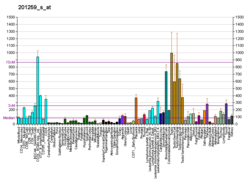| SYPL1 | |||||||||||||||||||||||||||||||||||||||||||||||||||
|---|---|---|---|---|---|---|---|---|---|---|---|---|---|---|---|---|---|---|---|---|---|---|---|---|---|---|---|---|---|---|---|---|---|---|---|---|---|---|---|---|---|---|---|---|---|---|---|---|---|---|---|
| Identifiers | |||||||||||||||||||||||||||||||||||||||||||||||||||
| Aliases | SYPL1, H-SP1, SYPL, synaptophysin like 1 | ||||||||||||||||||||||||||||||||||||||||||||||||||
| External IDs | OMIM: 616665; MGI: 108081; HomoloGene: 4915; GeneCards: SYPL1; OMA:SYPL1 - orthologs | ||||||||||||||||||||||||||||||||||||||||||||||||||
| |||||||||||||||||||||||||||||||||||||||||||||||||||
| |||||||||||||||||||||||||||||||||||||||||||||||||||
| |||||||||||||||||||||||||||||||||||||||||||||||||||
| |||||||||||||||||||||||||||||||||||||||||||||||||||
| |||||||||||||||||||||||||||||||||||||||||||||||||||
| Wikidata | |||||||||||||||||||||||||||||||||||||||||||||||||||
| |||||||||||||||||||||||||||||||||||||||||||||||||||
Synaptophysin-like protein 1 is a protein that in humans is encoded by the SYPL1 gene.
References
- ^ GRCh38: Ensembl release 89: ENSG00000008282 – Ensembl, May 2017
- ^ GRCm38: Ensembl release 89: ENSMUSG00000020570 – Ensembl, May 2017
- "Human PubMed Reference:". National Center for Biotechnology Information, U.S. National Library of Medicine.
- "Mouse PubMed Reference:". National Center for Biotechnology Information, U.S. National Library of Medicine.
- "Entrez Gene: SYPL1 synaptophysin-like 1".
Further reading
- Zhong CZ, Hayzer DJ, Runge MS (1992). "Molecular cloning of a cDNA encoding a novel protein related to the neuronal vesicle protein synaptophysin". Biochim. Biophys. Acta. 1129 (2): 235–8. doi:10.1016/0167-4781(92)90495-l. PMID 1730063.
- Leube RE (1994). "Expression of the synaptophysin gene family is not restricted to neuronal and neuroendocrine differentiation in rat and human". Differentiation. 56 (3): 163–71. doi:10.1046/j.1432-0436.1994.5630163.x. PMID 8034131.
- Haass NK, Kartenbeck MA, Leube RE (1996). "Pantophysin is a ubiquitously expressed synaptophysin homologue and defines constitutive transport vesicles". J. Cell Biol. 134 (3): 731–46. doi:10.1083/jcb.134.3.731. PMC 2120938. PMID 8707851.
- Sanger Centre, The; Washington University Genome Sequencing Cente, The (1999). "Toward a complete human genome sequence". Genome Res. 8 (11): 1097–108. doi:10.1101/gr.8.11.1097. PMID 9847074.
- Windoffer R, Borchert-Stuhlträger M, Haass NK, et al. (1999). "Tissue expression of the vesicle protein pantophysin". Cell Tissue Res. 296 (3): 499–510. doi:10.1007/s004410051310. PMID 10370136. S2CID 6765747.
- Brooks CC, Scherer PE, Cleveland K, et al. (2000). "Pantophysin is a phosphoprotein component of adipocyte transport vesicles and associates with GLUT4-containing vesicles". J. Biol. Chem. 275 (3): 2029–36. doi:10.1074/jbc.275.3.2029. PMID 10636906.
- Strausberg RL, Feingold EA, Grouse LH, et al. (2003). "Generation and initial analysis of more than 15,000 full-length human and mouse cDNA sequences". Proc. Natl. Acad. Sci. U.S.A. 99 (26): 16899–903. Bibcode:2002PNAS...9916899M. doi:10.1073/pnas.242603899. PMC 139241. PMID 12477932.
- Scherer SW, Cheung J, MacDonald JR, et al. (2003). "Human chromosome 7: DNA sequence and biology". Science. 300 (5620): 767–72. Bibcode:2003Sci...300..767S. doi:10.1126/science.1083423. PMC 2882961. PMID 12690205.
- Hillier LW, Fulton RS, Fulton LA, et al. (2003). "The DNA sequence of human chromosome 7". Nature. 424 (6945): 157–64. Bibcode:2003Natur.424..157H. doi:10.1038/nature01782. PMID 12853948.
- Ota T, Suzuki Y, Nishikawa T, et al. (2004). "Complete sequencing and characterization of 21,243 full-length human cDNAs". Nat. Genet. 36 (1): 40–5. doi:10.1038/ng1285. PMID 14702039.
- Gerhard DS, Wagner L, Feingold EA, et al. (2004). "The status, quality, and expansion of the NIH full-length cDNA project: the Mammalian Gene Collection (MGC)". Genome Res. 14 (10B): 2121–7. doi:10.1101/gr.2596504. PMC 528928. PMID 15489334.
- Chi A, Valencia JC, Hu ZZ, et al. (2007). "Proteomic and bioinformatic characterization of the biogenesis and function of melanosomes". J. Proteome Res. 5 (11): 3135–44. doi:10.1021/pr060363j. PMID 17081065.
This article on a gene on human chromosome 7 is a stub. You can help Misplaced Pages by expanding it. |





